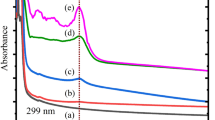Abstract
About 1 μm thick films of polystyrene (PS) and polymethylmethacrylate (PMMA) were prepared from solutions using spin-coating method. The PMMA films were doped with diphenylsulfoxide (DS) up to 45 wt%. Glass transition temperature (T g ) of doped PMMA films was determined by DSC technique and relative permittivity (ε) as a function of the sample temperature was determined from capacitance measurement. The dependence of polarization (P) on electric field (E) and the temperature was measured using a standard Sawyer-Tower circuit. Spectral dependence of film refractive index was measured using a refractometer. The glass transition temperature T g of PMMA/DS composite was found to be decreasing function of the DS concentration. Relative permittivity ε of unpolar PS is lower than that of polar PMMA. The PS permittivity does not depend on the sample temperature. For PMMA the permittivity is increasing function of both, DS dopant concentration and sample temperature. The dependence of the polarization on the electric field on PS film does not exhibit a hysteresis and indicate no polarization contrary to PMMA. PMMA/DS composites exhibit easier and larger polaribility and a permanent dipole moment. Resulting polarization is an increasing function of DS concentration. Refractive index of both pristine PS and PMMA decreases with increasing wave length. The refractive index of PMMA/DS composites depends on the DS concentration.
Similar content being viewed by others
References
E. RECHMANIS, in “Microelectronics Technology: Polymers for Advanced Imaging and Packaging” (American Chemical Society, Washington, DC, 1995).
S. YU, P. HING and X. HU, J. Appl. Phys. 88 (2000) 398.
B. PLOSS, B. PLOSS, F. G. SHIN, H. L. W. CHAN and C. L. CHOY, Appl. Phys. Lett. 76 (2000) 2776.
K. S. PATEL, P. A. KOHL and S. A. B. ALLEN, J. Polym. Sci. B38 (2000) 1634.
R. TECKLENBURG, G. PAASCH and S. SCHEINERT, Adv. Mater. Opt. Elektron. 8 (1998) 285.
H. B. SHARMA, H. N. K. SARMA and A. MANSINGH, J. Appl. Phys. 85 (1999) 341.
S. KIM, T. FUJIMOTO, T. MANABE, I. YAMAGUCHI, T. KUMAGAI and S. MIZUTA, J. Mater. Res. 14 (1999) 592.
B. H. HOERMAN, G. M. FORD, L. D. KAUFMANN and B. W. WESSELS, Appl. Phys. Lett. 73 (1998) 2248.
J. BENAVENTE, J. M. GARCIA, R. RILEY, A. E. LOZANO and J. DE ABAJO, J. Membr. Sci. 175 (2000) 43.
R. L. CLOUGHT, Nucl. Instrum. Meth. B185 (2001) 8.
A. RYTTEL, J. Macromol. Sci. A 34 (1997) 211.
L. C. COSTA, F. HENRY, M. A. VALENTE, S. K. MENDIRATTA and A. S. SOMARA, Eur. Polym. J. 38 (2002) 1495.
I. CENDOYA, D. POLEZ, A. ALGERIA and C. MIJANGOS, J. Polym. Sci. B39 (2001) 1968.
S. ETIENNE, C. STOCHMIL and J. L. BESSEDE, J. Alloys. Comp. 310 (2000) 368.
Y. BAI, Z. Y. CHEBY, V. BHARTI, S. H. XU and Q. M. ZHANG, Appl. Phys. Lett. 76 (2000) 3804.
H. S. NALWA, in “Ferroelectric Polymer” (Marcel Dekker, New York, 1995).
V. ŠVORČÍK, J. KRÁLOVÁ, V. RYBKA, J. PLEŠEK and V. HNATOWICZ, J. Polym. Sci. B39 (2001) 831.
V. ŠVORČÍK, R. GARDÁŠOVÁ, V. RYBKA, J. PLEŠ EK and V. HNATOWICZ, J. Appl. Polym. Sci. 91 (2004) 40.
C. B. SAWYER and C. H. TOWER, Phys. Rew. 35 (1930) 269.
J. M. KOO, J. KIM and E. G. LEE, J. Mater. Sci. Lett. 21 (2002) 653.
V. ŠVORČÍK, T. PODGRABINSKI, J. NÁ HLÍK, V. RYBKA and V. HNATOWICZ, Mater. Lett. 59 (2005) 341.
R. P. QUICK and M. A. A. ALSAMARRAIE, in “Polymer Handbook”, 3rd edition (John Wiley & Sons, New York, 1989).
E. A. SALEH and M. C. TEICH, in “Fundamentals of Photonics” (John Wiley & Sons, New York, 1991).
V. ŠVORČÍK, M. PRAJER, I. HUTTEL, V. RYBKA and J. PLEŠEK, Mater. Lett. 59 (2005) 280.
R. R. THOMAS, in “Fluorpolymers 2, Properties” (Plenum Press, New York, 1999).
V. ŠVORČÍ K, O. EKRT, V. RYBKA and J. LIPTÁK, J. Mater. Sci. Lett. 19 (2000) 1843.
D. K. LIDE, in “Handbook of Chemistry and Physics” (CRC Press, New York, 1996).
D. W. VAN KREVELEN, in “Properties of Polymers” (Elsevier, Amsterdam, 1976).
H. J. FRISSEL, Eng. Plast. 2 (1988) 467.
D. J. DAVID and A. MISTRA, in “Relating Materials Properties to Structure: Handbook and Software for Polymer Calculation and Materials Properties” (Technomic, Lancaster, 1999).
I. PROSYCEVAS, S. TAMULEVICIUS and A. GUOBIE- NE, Thin Solid Films 453 (2004) 304.
Author information
Authors and Affiliations
Corresponding author
Rights and permissions
About this article
Cite this article
Podgrabinski, T., Hrabovská, E., Švorčík, V. et al. Characterization of polystyrene and doped polymethylmethacrylate thin layers. J Mater Sci: Mater Electron 16, 761–765 (2005). https://doi.org/10.1007/s10854-005-4980-7
Received:
Accepted:
Issue Date:
DOI: https://doi.org/10.1007/s10854-005-4980-7




